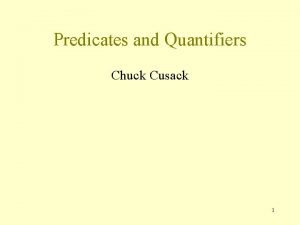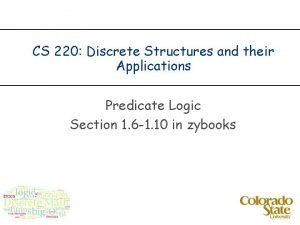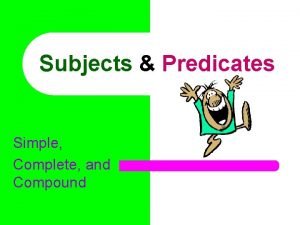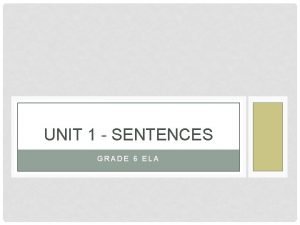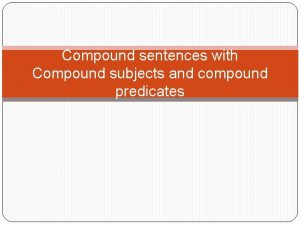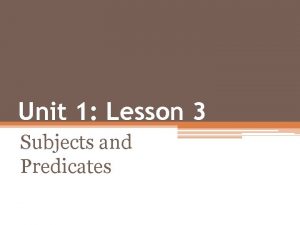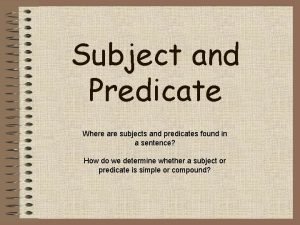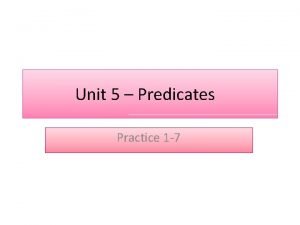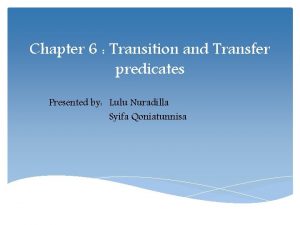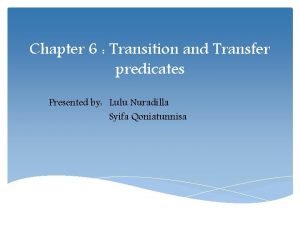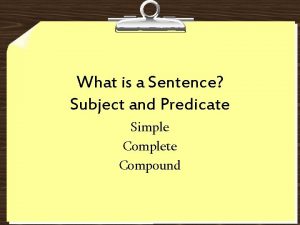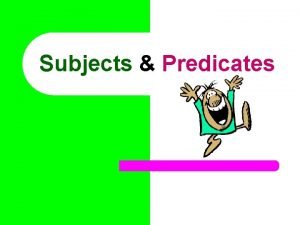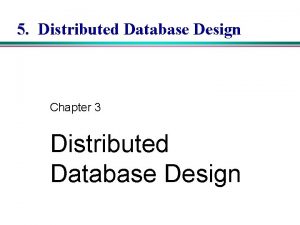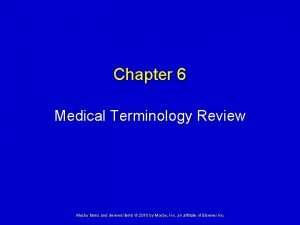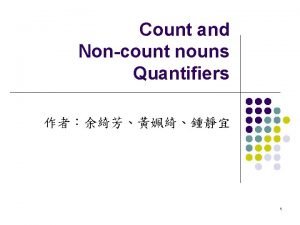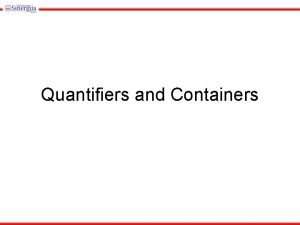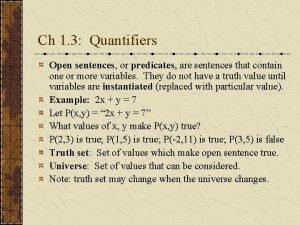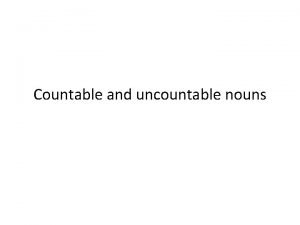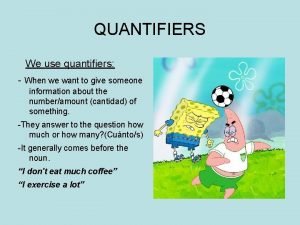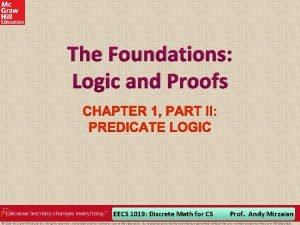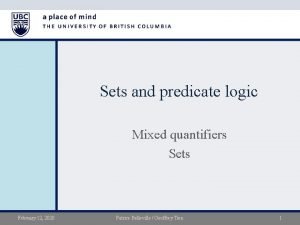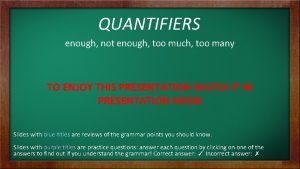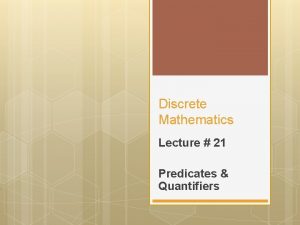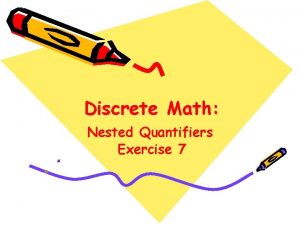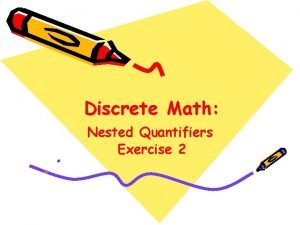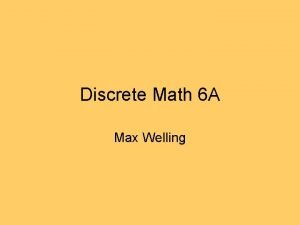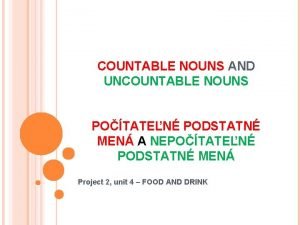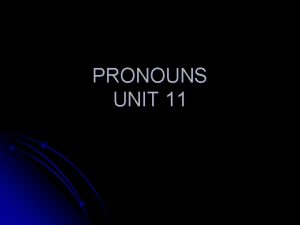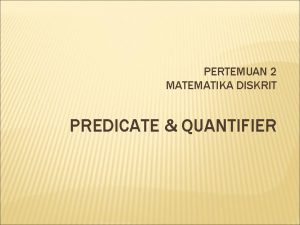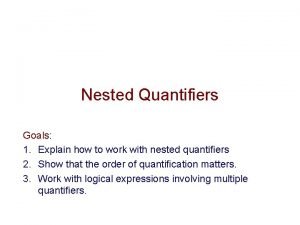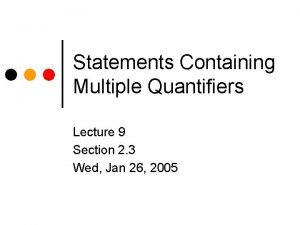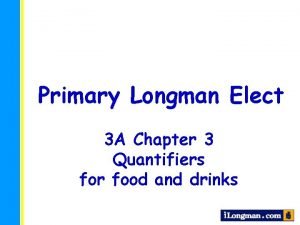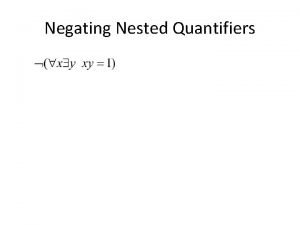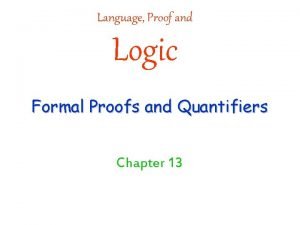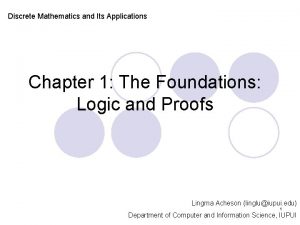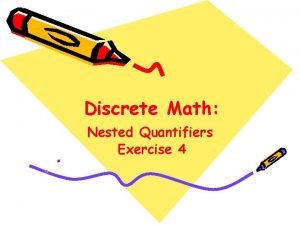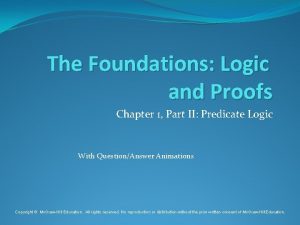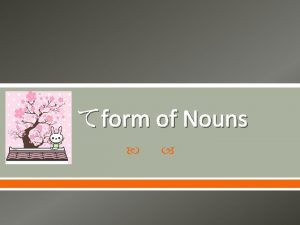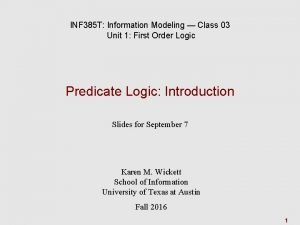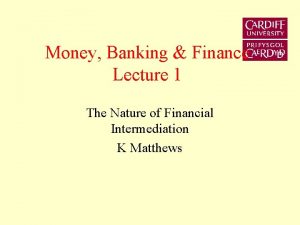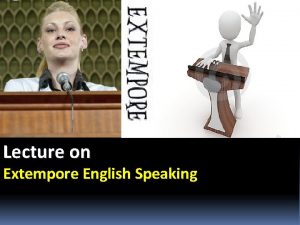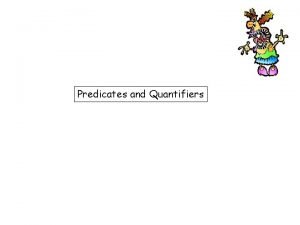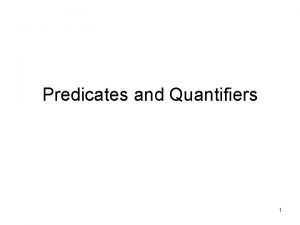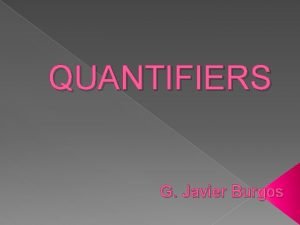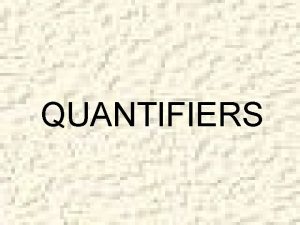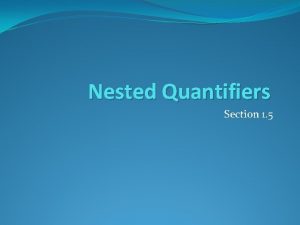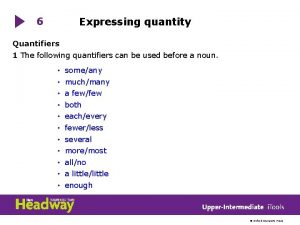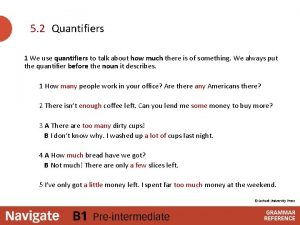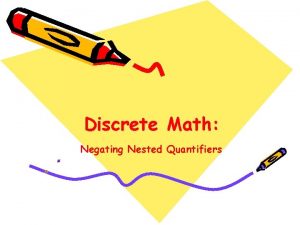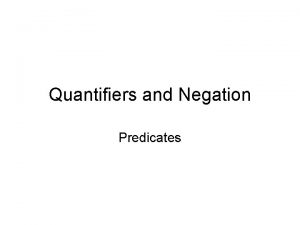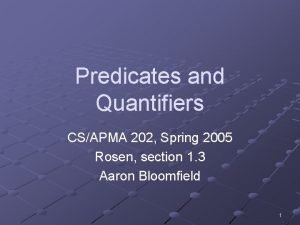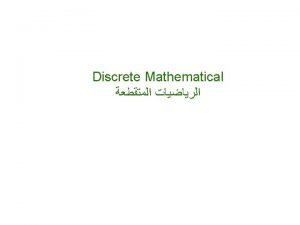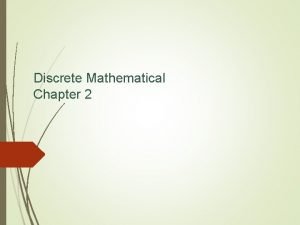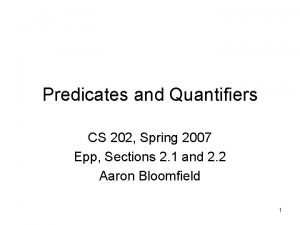PREDICATES AND QUANTIFIERS Lecture 15 1 TERMINOLOGY REVIEW







































































- Slides: 71

PREDICATES AND QUANTIFIERS Lecture # 15 1

TERMINOLOGY REVIEW � Proposition: - A statement that is either true or false - Must always be one or the other! � Example: � “The sky is red” � Not a proposition: x + 3 > 4 � Boolean variable: - A variable (usually p, q, r, etc. ) that represents a proposition. 2

� Consider the following statements: x > 3, x = y +3, x + y = z � We can make propositions out of such statements �A predicate is a property that is affirmed or denied about the subject (in logic: we say “variables” or “arguments”) of a statement. “ x is greater then 3” subject 3 predicate

� To write in a predicate logic: “ x is greater then 3” subject predicate � We introduce a (functional) symbol for the predicate, and put the subject as an argument (to the functional symbol): P(x). The statement P(x) is also said to be propositional function. � Examples: • • 4 Father(x): unary predicate Brother(x, y): binary predicate Sum(x, y, z): ternary predicate P(x, y, z, …t): n-ary predicate

PROPOSITIONAL FUNCTIONS � Consider P(x) = x < 5 � P(x) has no truth values (x is not given a value) � P(1) is true �The proposition 1 < 5 is true � P(10) is false �The proposition 10 < 5 is false � Thus, value. 5 P(x) will create a proposition when given a

EXAMPLE � Let P(x) denote the statement “x > 3”. What are truth values of P(4) and P(2)? � SOLUTION: P(x) = x > 3 P(4) = 4 > 3 P(4) = True P(x) = x > 3 P(2) = 2 > 3 P(2) = False 6

EXAMPLES � Let P(x) = “x is a multiple of 5” � For � Let P(x) = x+1 > x � For � Let what values of x is P(x) true? P(x) = x + 3 � For 7 what values of x is P(x) true?

ANATOMY OF A PROPOSITIONAL FUNCTION P(x) = x + 5 > x variable 8 predicate

PROPOSITIONAL FUNCTIONS INVOLVING MULTIPLE VARIABLES � Functions with multiple variables: � P(x, y) = x + y == 0 � P(1, 2) is false, P(1, -1) is true � P(x, y, z) = x + y == z � P(3, 4, 5) is false, P(1, 2, 3) is true � P(x 1, x 2, x 3 9 … xn) = …

DEFINITION �A predicate is a sentence that contains a finite number of variables and becomes a statement when specific values are substituted for the variables. � The domain of a predicate variable is the set of all values that may be substituted in place of the variable. 10

UNIVERSE OF DISCOURSE � Consider the statement ‘x > 3’, does it make sense to assign to x the value ‘blue’? � Intuitively, the universe of discourse is the set of all things we wish to talk about; that is the set of all objects that we can sensibly assign to a variable in a propositional function. Referred to as Domain. � What would be the universe of discourse for the propositional function below be: Enrolled. CSE 235(x)=‘x is enrolled in CSE 235’ 11

QUANTIFIERS � When the variables in a propositional function are assigned values, the resulting statement becomes a proposition with a certain truth values. � However, there is another important way, called quantification, to create a proposition from a propositional function. � Quantification expresses the extent to which a predicate is true over a range of elements. 12

� In English, the words all, some, many, none and few are used in quantification. � We will focus on two types of quantification here � Universal Quantification � Existential Quantification 13

� The � It statement ‘x > 3’ is not a proposition becomes a proposition When we assign values to the argument: ‘ 4>3’ is false, ‘ 2<3’ is true, or � When we quantify the statement � � Two quantifiers � Universal quantifier for all the proposition is true for all possible values in the universe of discourse � Existential quantifier exists 14

UNIVERSAL QUANTIFIER � Definition: The universal quantification of a predicate P(x) is the proposition ‘P(x) is true for all values of x in the universe of discourse. ’ � Notation: We use the notation: x P(x), which is read ‘for all x’. � If the universe of discourse is finite, say {n 1, n 2, …, nk}, then the universal quantifier is simply the conjunction of the propositions over all the elements x P(x) P(n 1) P(n 2) … P(nk) 15

UNIVERSAL QUANTIFIER � Represented by an upside-down A: � It means “for all” � Let P(x) = x+1 > x � We can state the following: � x P(x) � English translation: “for all values of x, P(x) is true” � English translation: “for all values of x, x+1>x is true” 16

EXAMPLE � Let the universe be the real numbers. � Then, � Let x P(x) is true P(x) = x/2 < x � Not true for the negative � Thus, x P(x) is false � When numbers! the domain is all the real numbers � In order to prove that a universal quantification is true, it must be shown for ALL cases. � In order to prove that a universal quantification is false, it must be shown to be false for only ONE case 17

LOOP � Think � x �… of as a for loop: P(x), where 1 ≤ x ≤ 10 can be translated as … for ( x = 1; x <= 10; x++ ) is P(x) true? � If � 18 P(x) is true for all parts of the for loop, then x P(x) Consequently, if P(x) is false for any one value of the for loop, then x P(x) is false

REMEMBER � The truth value of x P(x) depends on the domain/universe of discourse! statement x P(x) is false. If and only If P(x) is not always true when x is in the domain. �A � One way to show that P(x) is not always true when x is in the domain is to find a counterexample. �A single counter example is all we need to establish that x P(x) is false. 19

EXAMPLE � Let Q(x) be the statement “x < 2”. What is the truth value of the quantification x Q(x), where the domain consists of all real numbers? � Solution: Q(x) is not true for every real number x Counter Example: Let x = 3 Q(3) is false Thus, x Q(x) is false. 20

EXAMPLE is the truth value of x P(x), where P(x) is the statement “x 2 < 10” and the domain consists of the � What positive integers not exceeding 4? � Solution: The statement x P(x) is the same as the conjunction P(1) P(2) P(3) P(4) P(1) is true P(2) is true P(3) is true P(4) is false P(4), which is the statement “ 42 < 10” is false, Thus, x P(x) is false. 21

EXAMPLE � a) What is the truth value of x (x 2 ≥ x), if the domain consists of all real numbers? b) What is the truth value of x (x 2 ≥ x), if the domain consists of all integers? a) Solution: The universal quantification (x 2 ≥ x) is not true for every real number x Counter Example: Let x = ½ (1/2)2 ≥ (1/2) is false 22

b) Solution: The universal quantification (x 2 ≥ x) is true for all integers. 23

EXISTENTIAL QUANTIFICATION � Definition: The existential quantification of a predicate P(x) is the proposition ‘There exists a value x in the universe of discourse such that P(x) is true. ’ � Notation: We use the notation: x P(x), which is read ‘there exists x’. � If the universe of discourse is finite, say {n 1, n 2, …, nk}, then the existential quantifier is simply the disjunction of the propositions over all the elements x P(x) P(n 1) P(n 2) … P(nk) 24

� Represented by an backwards E: � It means “there exists” � Let P(x) = x+1 > x � We � x can state the following: P(x) � English translation: “there exists (a value of) x such that P(x) is true” � English translation: “for at least one value of x, x+1>x is true” 25

EXAMPLE � Let P(x) = x+1 > x � There is a numerical value for which x+1>x �In fact, it’s true for all of the values of x! � Thus, x P(x) is true � In order to show an existential quantification is true, you only have to find ONE value � In order to show an existential quantification is false, you have to show it’s false for ALL values 26

EXAMPLE � Let P(x) be the statement “x > 3. ” What is the truth value of the quantification x P(x), where the domain consists of all real numbers? � Solution: P(x) is true for some values in domain Counter Example: Let x = 4 P(4) is true Thus, x P(x) is true. 27

EXAMPLE � Let Q(x) be the statement “x = x + 1. ” What is the truth value of the quantification x Q(x), where the domain consists of all real numbers? � Solution: Q(x) is false for every real number x. Counter Example: Let x = 6 Q(6) = 6 + 1 is false Thus, x Q(x) is false. 28

EXAMPLE is the truth value of x P(x), where P(x) is the statement “x 2 > 10” and the universe of discourse consists of � What the positive integers not exceeding 4? � Solution: The statement x P(x) is the same as the disjunction P(1) P(2) P(3) P(4) P(1) is false P(2) is false P(3) is false P(4) is true P(4), which is the statement “ 42 < 10” is true Thus, x P(x) is true 29

NOTE � Recall � Let that P(x) is a propositional function P(x) be “x == 0” � Recall that a proposition is a statement that is either true or false � P(x) is not a proposition � There are two ways to make a propositional function into a proposition: � Supply � For it with a value example, P(5) is false, P(0) is true � Provide � For 30 a quantification example, x P(x) is false and x P(x) is true Let the universe of discourse be the real numbers

QUANTIFIERS: Truth values � In general, when are quantified statements true or false? Statement True when… x P(x) False when. . . There is an x for which P(x) is true for every x P(x) is false There is an x for which P(x) is false for every x P(x) is true

UNIQUENESS QUANTIFIER � The Uniqueness quantifier, denoted by ! or 1. � Notation: � ! x P(x) [or 1 x P(x)] states “there exist a unique x such that P(x) is true” � Other phrases for uniqueness quantification include “there is exactly one” and “there is one and only one. ” 32

EXAMPLE � ! x (x - 1 = 0), where the domain is the set of real numbers. � Solution: (x - 1 = 0) is true for a unique real number. Counter Example: Let x = 1 (x - 1 = 0) is true Note: Generally, uniqueness quantifier is avoided. It is best to stick with existential and universal quantifier. 33

QUANTIFIERS WITH RESTRICTED DOMAINS � EXAMPLE: What do statements x < 0 (x 2 > 0), y ≠ 0 (y 3 ≠ 0) and z > 0 (z 2 =2) SOLUTION: The statement x < 0 (x 2 > 0) states that for every real number x with x < 0, x 2 > 0. That is, “the square of negative real number is positive. ” The statement is the same as: x (x < 0 34 → x 2 > 0).

statement y ≠ 0 (y 3 ≠ 0) states for every real number y with y ≠ 0, we have (y 3 ≠ 0). � The That is, “the cube of every nonzero real number is nonzero. ” This statement is equivalent to: y(y ≠ 0 → y 3 ≠ 0) 35

statement z > 0 (z 2 =2) states that there exist a real number z with z > 0 such that z 2 =2. � The That is, “There is a positive square root of 2. ” This statement is equivalent to: z (z > 0 z 2 =2). 36

NOTE: � The restriction of a universal quantification is the same as the universal quantification of a conditional statement. Example: x < 0 (x 2 > 0) is another way of expressing x (x < 0 → x 2 > 0) � The restriction of existential quantification is the same as the existential quantification of a conjunction. Example: 37 z > 0 (z 2 =2) is another way of

PRECEDENCE OF QUANTIFICATION � The quantifiers and have higher precedence than all logical operators from propositional calculus. � Example: x P(x) Q(x) is the disjunction of x P(x) and Q(x). � In other words, � It means ( x P(x)) Q(x) rather than x (P(x) Q(x)). 38

BINDING VARIABLES � When a quantifier is used on the variable x, we say that the occurrence of the variable is bound. � An occurrence of a variable that is not bound by a quantifier is said to be free. � The part of a logical expression to which a quantifier is applied is called the scope of this quantifier. 39

EXAMPLE � In the statement x (x + y =1), �The variable x is bound to by the existential quantification x. � The variable y is free because it is not bound by a quantifier. x (x + y =1), x is bound, but y is free. 40

EXAMPLE the statement x (P(x) Q(x)) x R(x), all variables are bound. � In scope of the first quantifier, x, is the expression (P(x) Q(x)) � The scope of the second quantifier, x is the expression R(x) � That is, the existential quantifier binds the variable x in P(x) Q(x) � 41 Universal quantifier binds the variable x in R(x). � The

EXAMPLES � ( x P(x)) Q(x) � The � ( x x in Q(x) is not bound; thus not a proposition P(x)) ( x Q(x)) � Both � ( x P(x) Q(x)) ( y R(y)) � All � ( x variables are bound; thus it is a proposition P(x) Q(y) ( y R(y)) � The 42 x values are bound; thus it is a proposition y in Q(y) is not bound; this not a proposition

BINDING VARIABLES � Let P(x, y) be x > y � Consider: x P(x, y) � This is not a proposition! � What is y? �If it’s 5, then x P(x, y) is false �If it’s x-1, then x P(x, y) is true � Note 43 that y is not “bound” by a quantifier

LOGICAL EQUIVALENCES INVOLVING QUANTIFIERS � Two statements S and T involving predicates and quantifiers are logically equivalent if and only if they have the same truth value regardless of the interpretation, i. e. regardless of � The meaning that is attributed to each propositional function. � The domain of discourse. � Notation: use the notation S T to indicate that two statements S and T involving predicates and quantifiers are logically equivalent. � We 44

EXAMPLE x (P(x) Q(x)) logically equivalent to x P(x) x Q(x)? where the same domain is used throughout. � Is � Solution: � Use � If two steps x (P(x) Q(x)) is true, then x P(x) x Q(x) is true � Proof: Suppose x (P(x) Q(x)) is true. Then if a is in the domain, P(a) Q(a) is true, So P(a) is true and Q(a) is true. � So, if a is in the domain P(a) is true, which is the same as x P(x) is true; and similarly, we get that x P(x) is true 45

TRANSLATING FROM ENGLISH INTO LOGICAL EXPRESSIONS � Example: Express the statement using predicates and quantifiers. “Every student in this class has studied calculus” Solution: � Step 1: First we rephrase the statement so that we can clearly identify the appropriate quantifiers to use. “For every student in this class, that student has studied calculus. ” � Step 46 2: Introduce a variable x “For every student x in this class, x has studied calculus”

� Step 3: Introduce C(x) = x has studied calculus. Domain = Students in the class. Step 4: x C(x) 47

EXAMPLE � Express the statement using predicates and quantifiers. “For every person x, If person x is a student in this class then x has studied calculus. ” Solution: � Step 1: � Step 2: � Step 3: Introduce S(x) and C(x) S(x) = Person x is in the class. C(x) = x has studied Calculus. Domain = Students in the class. � Step 4: x (S(x) → C(x)) 48

EXAMPLE � Express the statement using predicates and quantifiers. “Some student in this class has visited Mexico” Solution: � Step 1: First we rephrase the statement so that we can clearly identify the appropriate quantifiers to use. “There is a student in this class with the property that the student has visited Mexico” � Step 2: Introduce a variable x “There is a student x in this class having the property that x has visited Mexico” 49

� Step 3: Introduce M(x) = x has visited Mexico. Domain = Students in the class. Step 4: x M(x) 50

EXAMPLE � Express the statement using predicates and quantifiers. “There is a person x having the properties that x is a student in this class and x has visited Mexico. ” Solution: � Step 1: � Step 2: � Step 3: Introduce S(x) and M(x) S(x) = x is a student in this class. M(x) = x has visited Mexico. Domain = All person. � Step 4: x (S(x) M(x)) 51

EXAMPLE � Express the statement using predicates and quantifiers. “For every x in this class, x has the property that x has visited Mexico or x has visited Canada. ” Solution: � Step 1: � Step 2: � Step 3: Introduce C(x) and M(x) C(x) = x has visited Canada. M(x) = x has visited Mexico. Domain = All people. � Step 4: x (C(x) M(x)) 52

EXAMPLE � Express the statement using predicates and quantifiers. “For every person x, if x is a student in this class, then x has visited Mexico or x has visited Canada. ” Solution: � Step 1: � Step 2: � Step 3: Introduce S(x) and M(x) S(x) = x is a student in this class. C(x) = x has visited Canada. M(x) = x has visited Mexico. Domain = student in the class. � Step 4: x (S(x) → (C(x) M(x))). 53

EXAMPLES FROM LEWIS CARROL � Consider these statements. The first two are called premises and the third is called the conclusion. The entire set is called an argument. “All lions are fierce. ” “Some lions do not drink coffee. ” Therefore, “Some fierce creatures do not drink coffee. ” 54

SOLUTION � Let P(x) = “x is a lion. ” Q(x) = “x is fierce. ” R(x) = “x drinks coffee. ” Domain = Assume all creatures. � We can express these statements as: � “All lions are fierce. ” � x (P(x) → Q(x)). 55

� “Some lions do not drink coffee. ” x (P(x) ¬R(x)). � “Some fierce creatures do not drink coffee. ” x (Q(x) ¬R(x)). 56

MORE EXAMPLES � Translate the statements: � “All hummingbirds are richly colored” � “No large birds live on honey” � “Birds that do not live on honey are dull � “Hummingbirds are small” in color” � Solution: Assign propositional functions Let P(x) = “x is a hummingbird” Q(x) = “x is large” R(x) = “x lives on honey” S(x) = “x is richly colored” Let our universe of discourse be all birds 57

� Translate the statements: � Assume that “small” is the same as “not large” and that “dull in color” is the same as “not richly colored” � “All hummingbirds � x (P(x)→S(x)) are richly colored” � “No large birds live on honey” �¬ x (Q(x) R(x)) �Alternatively: x (¬Q(x) ¬R(x)) � “Birds that do not live on � x (¬R(x) → ¬S(x)) honey are dull in color” � “Hummingbirds are small” � x (P(x) → ¬Q(x)) 58

NEGATING QUANTIFIED EXPRESSIONS � Consider the statement: “Every student in your class has taken a course in calculus. ” P(x) = x has taken a course in calculus. Domain = Students in your class. x P(x) 59

� The negation of this statement is “It is not the case that every student in your class has taken a course in calculus. ” � This is equivalent to “There is a student in your class who has not taken a course in calculus. ” x ¬P(x) 60

� This example illustrate the following logical equivalence: ¬ x P(x) x ¬P(x) 61

NOTE note that ¬ x P(x) is true if and only if x P(x) is false. � First that x P(x) is false if and only if there is an element x in domain for which P(x) is false. � Note � Finally, note that there is an element x in the domain for which ¬ P(x) is true if and only if x ¬P(x) is true. � Putting these steps together, we can conclude that: ¬ x P(x) is true if and only if x ¬P(x) is true. 62

follows that ¬ x P(x) and x ¬P(x) are logically equivalent. � It 63

� Another example illustrate that following logical equivalence: ¬ x Q(x) x ¬Q(x) 64

EXAMPLE � What are the negations of the statements: “There is an honest politician” � Solution: H(x) = x is a honest. Domain = all politician x H(x) The negation of this statement is ¬ x H(x) = x ¬H(x) “Every politician is dishonest. ” 65

EXAMPLE � What are the negations of the statements: “All Americans eat cheeseburgers” � Solution: C(x) = x eats cheeseburgers. Domain = all Americans x C(x) The negation of this statement is ¬ x C(x) = x ¬C(x) “Some Americans does not eat cheeseburgers. ” 66

EXAMPLE � What are negations of the statement: x (x 2 > x) � Solution: The negation of x (x 2 > x) is the statement ¬ x (x 2 > x) = x ¬(x 2 > x) This can be re-written as: x (x 2 ≤ x) 67

EXAMPLE � What are negations of the statement: x (x 2 = 2) � Solution: The negation of x (x 2 = 2) is the statement ¬ x (x 2 = 2) = x ¬(x 2 = 2) This can be re-written as: x (x 2 ≠ 2) 68

EXMPLE that ¬ x (P(x)→Q(x)) and x (P(x) ¬Q(x)) are logically equivalent. � Show � Solution: ¬ x (P(x)→Q(x)) x ¬(P(x)→Q(x)) Given De Morgan’s law for universal quantifiers x ¬(¬P(x) Q(x)) As we know that p → q = ¬p q x (¬(¬P(x)) ¬Q(x)) De-Morgan’s law x (P(x) ¬Q(x)) Double Negation law R. H. S 69

EXMPLE � Express the negation of x y. P(x, y) x y. Q(x, y). � Solution: ¬( x y. P(x, y) x y. Q(x, y)) ¬( x y. P(x, y) ¬ x y. Q(x, y) x¬ y. P(x, y) x¬ y. Q(x, y) x y ¬P(x, y) x y ¬Q(x, y) 70 Given De Morgan’s law De-Morgan’s law

LOGIC PROGRAMMING � An important type of programming language is designed to reason using the rules of predicate logic. � Prolog (Programming in Logic) � Developed in 1970 s by computer scientists working in the area of artificial intelligence. 71
 Quantifiers
Quantifiers Applications of predicates and quantifiers
Applications of predicates and quantifiers 01:640:244 lecture notes - lecture 15: plat, idah, farad
01:640:244 lecture notes - lecture 15: plat, idah, farad Whats a complete subject
Whats a complete subject Complete compound subject
Complete compound subject Unit 1 subjects predicates and sentences
Unit 1 subjects predicates and sentences Subject examples sentences
Subject examples sentences Draw a line between the complete subject and predicate
Draw a line between the complete subject and predicate 20 sentences with subject and predicate
20 sentences with subject and predicate Subject and predicate assessment
Subject and predicate assessment Procedural versus declarative knowledge in ai
Procedural versus declarative knowledge in ai Unit 5 quick quiz 1
Unit 5 quick quiz 1 Lesson 3 subjects and predicates
Lesson 3 subjects and predicates Transition and transfer predicates
Transition and transfer predicates Transition and transfer predicates
Transition and transfer predicates Simple predicet
Simple predicet What are simple predicates
What are simple predicates Com_min algorithm
Com_min algorithm Mosby pronunciation
Mosby pronunciation Quantifier for air
Quantifier for air Nouns
Nouns Quantifiers and containers
Quantifiers and containers Quantifiers determiners
Quantifiers determiners Ch q
Ch q Mass noun in a sentence
Mass noun in a sentence When we use in
When we use in Nested quantifiers
Nested quantifiers Geoffrey tien
Geoffrey tien A little and little meaning
A little and little meaning Very little very few
Very little very few Kahoot too enough
Kahoot too enough Phrasal quantifiers
Phrasal quantifiers Let l(x y) be the statement x loves y where the domain
Let l(x y) be the statement x loves y where the domain Nested quantifiers exercises
Nested quantifiers exercises Nested quantifiers exercises
Nested quantifiers exercises Nested quantifiers
Nested quantifiers Countable nouns uncountable nouns
Countable nouns uncountable nouns Is a a pronoun
Is a a pronoun Existensial quantifier berarti
Existensial quantifier berarti Negating nested quantifiers
Negating nested quantifiers Quantifiers tabela
Quantifiers tabela What are determiners
What are determiners Deteriminer
Deteriminer Multiply quantified statements
Multiply quantified statements Quantifier for bread
Quantifier for bread Let i(x) be the statement x has an internet connection
Let i(x) be the statement x has an internet connection Language, proof and logic
Language, proof and logic Precedence of quantifiers
Precedence of quantifiers Nested quantifiers discrete math
Nested quantifiers discrete math Mark the right alternative about quantifiers
Mark the right alternative about quantifiers Quantifiers to make comparisons
Quantifiers to make comparisons Snurds
Snurds Form nouns
Form nouns Soda is countable or uncountable
Soda is countable or uncountable Phrasal quantifiers
Phrasal quantifiers Compound quantifiers
Compound quantifiers Qunatifiers
Qunatifiers Butterfly singular possessive
Butterfly singular possessive Chapter review motion part a vocabulary review answer key
Chapter review motion part a vocabulary review answer key Ap gov final review
Ap gov final review Nader amin-salehi
Nader amin-salehi What is inclusion and exclusion criteria
What is inclusion and exclusion criteria Narrative review vs systematic review
Narrative review vs systematic review Magnetism
Magnetism Power system dynamics and stability lecture notes
Power system dynamics and stability lecture notes Microbial physiology and metabolism lecture notes
Microbial physiology and metabolism lecture notes Ternology
Ternology Cloud computing lecture
Cloud computing lecture Fits and tolerances chart
Fits and tolerances chart Financial markets and institutions ppt
Financial markets and institutions ppt Indirect finance
Indirect finance Extempore and lecture
Extempore and lecture
